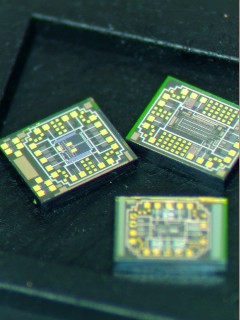Jul 31 2015
The surface of Venus is the most hostile environment in the solar system. The temperature on Venus can reach 500 degrees Celsius – hot enough to melt lead. NASA, in a quest to build a rover to explore the Venusian surface, as awarded two grants totaling nearly $245,000 to Ozark Integrated Circuits Inc., a technology firm affiliated with the University of Arkansas, to design heat-resistant circuits for a proposed Venus Landsailing Rover.
 Ozark IC silicon-carbide chip. Credit:Ozark Integrated Circuits
Ozark IC silicon-carbide chip. Credit:Ozark Integrated Circuits
The company will collaborate with electrical engineering students at the U of A on one of the projects. It will also utilize the integrated circuit packaging expertise and facilities of the university’s High Density Electronics Research Center at the research park. In electronics manufacturing, circuit packaging is the final stage of semiconductor device fabrication.
“Silicon carbide is a semiconductor that is ideally suited for the extreme environments found on Venus,” said Matt Francis, Ozark IC's president and chief executive officer. “We have many years of experience working with this semiconductor fabrication process, developing models and process-design kits specifically for this process.”
Francis and Jim Holmes, the company’s chief technology officer, have perfected design procedures, tools, characterization and modeling approaches that have enabled them, in conjunction with researchers at the University of Arkansas, high-temperature, to design high-voltage electronics capable of operating at conditions beyond 600 degrees Fahrenheit.
“We will demonstrate the feasibility of creating these needed integrated circuits,” Francis said. “We will also generate a commercial feasibility analysis based on projections of the manufacturing costs for each of these integrated circuits.”
In the first NASA award, Ozark IC will address NASA’s Earth and planetary science missions through the development of a reliable ultraviolet imager that is ideally suited for planetary composition experiments and Earth observation in space. The imager will allow monitoring of ultraviolet signals in order to understand the environment on Venus as well as for ultraviolet astronomy by observing and analyzing other planets and stars.
In the second award, the company will address NASA’s need for a microcontroller to provide real-time programmability for the proposed mobile lander for Venus. Alan Mantooth, Distinguished Professor of electrical engineering at the U of A, will supervise student research on this project.
The Phase I grants came through the Small Business Innovation Research Program, which allows federal agencies to stimulate technological innovation in the private sector by strengthening small businesses that meet federal research and development needs. The program also is intended to increase the commercial application of federally supported research results.